|
Where did the money come from?
"And
the money came rolling in!" Millions have heard these lyrics from Andrew
Lloyd Weber's Opera Evita.
Unfortunately, as pointed out in other documents
on the Evita website, the Opera Evita is based on a "biography"
of Evita written by María Flores, a pseudonym for Mary Main, whose book
contains no footnotes, 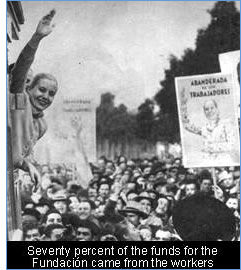 references,
sources or documented interviews to lend it credibility. references,
sources or documented interviews to lend it credibility.
On June 19, 1948, Decree 220.564 formally
established the Fundación de Ayuda Social María Eva Duarte de Perón. Evita
donated $10,000 Argentine pesos as its initial patrimony. On October 13,
1955, when the military government confiscated its goods, the Fundación
had assets of three billion two hundred eighty million four hundred fifty
eight thousand eight hundred and twelve pesos.(1)
Where DID the money come from?
Seventy percent of the Fundación's capital
was donated by the workers.
Both Marysa Navarro and Nestor Ferioli (2)
state that most of the Fundación's money came from donations; it is Ferioli
who specifies that seventy percent of its capital came from workers' donations.
(3)
He
cites seven sources of revenue for Evita's Foundation : (4)
- labor
union contributions stipulated by law
- spontaneous
donations given by affiliated or unionized workers
- percentages
deducted under collective bargaining agreements
- state,
provincial or municipal subsidies
- donations
from businesses
- donations
from individuals
- incidental
resources
The
fact that in Argentina laws were passed which designated funds for the
Fundación was not an innovation created by the Peronista majority in Congress.
For example, in 1945, the budget for the Society of Beneficence was $22,232,280
Argentine pesos and $21,889,906 of those pesos came from the Argentine
government as a subsidy (which means that the private sector contributed
only $342,374 pesos to the Society). Other institutions received government
subsidies but none as generously as the Society of Beneficence. (5)
The Radical minority in Congress, vehemently opposed to giving money to
Evita's Fundación, had never opposed the previous governments' largess
to the Society of Beneficence. A Spanish biographer of Evita's found that
strange: "The Radical Party never opposed the old ladies who received
State funds nor the ostentation with which they carried out their charity
works." (6)
From 1950 to 1955, laws and decrees assigned
resources to the Fundación: (7)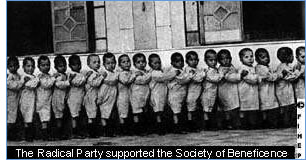
•
Law 13.941 (9-30-50) increased the Buenos Aires Racetrack ticket by three
percent
• Resolution 266 (10-6-50) required
that the CGT retain and deposit the salaries for May 1 and October 12
in the National Bank to be transferred to the Fundación
• Law 13.992 (10-31-50) designated
a two percent contribution that employers should discount from the annual
bonus salary (the "aguinaldo") given to workers
• Law 5.627 from Buenos Aires Province
(11-16-50) established an additional three percent tax on the bets placed
at the Provincial Racetrack
• Law 14.044 (8-2-51) gave the Fundación
gambling fines collected as stipulated by Law 4097
• Law 14.060 (1951) Argentina Mixta
Telefónica gave the Fundación a one-time contribution
• Decree 7025 (4-13-51) gave eight
to twenty percent raises to all National Public Administration Personnel
as well as additional cost of living and family salary increases: from
this raise a percentage was destined for the Fundación
• Decree 6000 (3-25-52) brought up
to date the raises obtained through Decree 7025
• Law 14231 (10-31-53) established
obligatory life insurance for spectators and participants of sporting
events and the Fundación received fifty percent of net profits after operating
expenses.
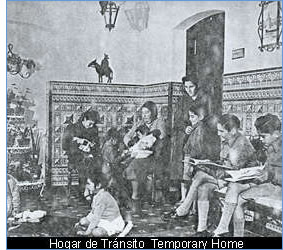 Seventy percent of all funds came from the workers themselves. Ferioli
cites the first semester of 1949 as an example. Of the total donations
of cash and goods received by Evita, sixty-four percent came from syndicates
and workers' unions; the rest was divided equally: eighteen percent came
from delegations of workers not represented by unions, and eighteen percent
came from private citizens [specifically, one million one hundred thousand
pesos was donated by the Railroad Workers Union on May 11; ... 5,000 beds
were donated by Robert Sherower from the Products Transportation Line,
Inc. of New York]. (8)
Seventy percent of all funds came from the workers themselves. Ferioli
cites the first semester of 1949 as an example. Of the total donations
of cash and goods received by Evita, sixty-four percent came from syndicates
and workers' unions; the rest was divided equally: eighteen percent came
from delegations of workers not represented by unions, and eighteen percent
came from private citizens [specifically, one million one hundred thousand
pesos was donated by the Railroad Workers Union on May 11; ... 5,000 beds
were donated by Robert Sherower from the Products Transportation Line,
Inc. of New York]. (8)
Many one-time donations came from unions
as a result of Evita's arbitration between employers and employees. Evita
was able to mediate their differences and the contracts signed often had
a special clause which gave a percentage of the workers' raises to the
Fundación (the bigger the raise, the more the Fundación received). For
example, the Office Supply Workers' Contract #128, signed on September
21, 1950, gave two percent of the first month's salary increase to the
Fundación while the Commerce Employees' Contract #141, signed on July
31, 1950, gave half of the employees' raises for the months of May and
June, 1950, to the Fundación.
In 1948, Rafael Urruela, President of the
Inter-American News Association, visited Argentina and spent time with
Perón and Evita. One afternoon he was with her when she met with various
delegations who had brought contributions to the Fundación. He listed
the donors and the amounts of their contributions as follows:
-
Syndicate of Gelatin Workers
- Normal
School #3 of Almafuerte
- Employees of National Mortgage Bank
- Personnel of the Martona Factory
- Workers of the Vascongada
- Coordinating Committee of the Municipal Slaughterhouse
- Confederation of River Pilots
|
600
7,740
25,100
7,800
6,065
1,600
5,000 (9) |
The
CGT was responsible for collecting the contributions and depositing them
in an account which the Fundación maintained in the Banco de la Nación
Argentina. (10)
The State also destined a part of its annual
budget to the Fundación to subsidize pensions, retirement funds, and secondary
school scholarships. However, since the amount fluctuated according to
each year's economic plan, Dr. Cereijo (the Fundación's prudent administrator)
proposed that instead of a variable sum which depended on the national
budget, the Fundación be given the increase in sales tax determined by
Law 13.343 as a sales tax would produce a more stable financial yield.
His efforts were in vain. (11)
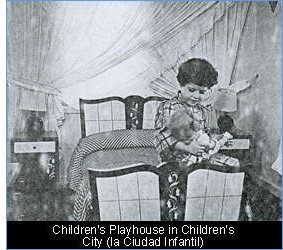 Evita
tried not to handle cash. She witnessed the giving of the donations but
they were received by the Minister of the Treasury or by the administrator
of the Fundación and deposited. The donors were always given a receipt.
Frequently private citizens wanted to help with a contribution to her
social work. For example, in her will, María Sebastiani de Miniaci left
one million two hundred thousand pesos to the Fundación to build a home
school. On January 14, 1949, Democracia carried the story of José
Rodriguez García who used part of his lottery money to buy a house and
donated the rest to the Fundación. In La Razón de Mi Vida, Evita
tells about a woman to whom the Fundación had sent a sewing machine. The
woman sent five pesos from her first earnings to Evita. The Fundación
gave away thousands of sewing machines. Clearly Evita remembered the importance
of a sewing machine as a means of earning money to support a single parent
family. Evita
tried not to handle cash. She witnessed the giving of the donations but
they were received by the Minister of the Treasury or by the administrator
of the Fundación and deposited. The donors were always given a receipt.
Frequently private citizens wanted to help with a contribution to her
social work. For example, in her will, María Sebastiani de Miniaci left
one million two hundred thousand pesos to the Fundación to build a home
school. On January 14, 1949, Democracia carried the story of José
Rodriguez García who used part of his lottery money to buy a house and
donated the rest to the Fundación. In La Razón de Mi Vida, Evita
tells about a woman to whom the Fundación had sent a sewing machine. The
woman sent five pesos from her first earnings to Evita. The Fundación
gave away thousands of sewing machines. Clearly Evita remembered the importance
of a sewing machine as a means of earning money to support a single parent
family.
Another type of incidental resources were
those received ad hoc, such as the fine imposed on the heirs of Otto Bemberg
for tax evasion, a large sum which Law 14.028/51 transferred to the Fundación
(although the money was never received). (12)
As Néstor Ferioli states, (13)
Evita was not a Robin Hood in skirts. She did not steal from the rich
to give to the poor. However, her enemies were so convinced that money
was obtained by extortion that after the military coup of 1955, businessmen
were invited to report any incidents of extortion or graft. Even though
two commissions were formed to deal with their complaints, only one accusation
was made (by the furniture company Sagasti) and they lost the case. The
Fundación had refused to pay for beds not made to specifications and of
an inferior quality of wood. The commissions had to overrule Sagasti's
demands for reimbursement. (14)
As Ferioli points out, "According to Peronistas
from Perón's first presidency, donations from companies and businesses
were the result of reciprocal convenience. 'Evita asked for nothing; she
didn't search for or demand anything.' She helped them get credits from
the Argentine Institute for the Promotion of Industry, and they, motivated
either by gratitude or interest in obtaining a credit, made donations
of cash or goods to the Fundación. This arrangement was not unique to
Evita: throughout history businessmen have sought this kind of attention
from whatever government was in power." (15)
Evita did have business connections with
her good friend Dodero, the shipping magnate, and the Fortabat family
who donated cement used in the construction of the Fundación's buildings.
Evita thanked those who helped with donations. When she inaugurated the
Ciudad Infantil ( the Children's City) in 1949, she expressed her gratitude
to many donors, among them the Tienda Los Gobelinos, Lutz Ferrrando, and
Au Mueble Rustique. (16)
The biography Evita by Marysa Navarro contains
a breakdown of the Fundación's resources in its 1953 Memoria: (17)
-
Cash donations
- Collective
Bargaining Agreements
- Resolution #266
- Rents
- Cinema Covenant
- Hotels and Vacation Colonies
- "General San Martín" Working Women's Home
- Lotteries
- Law 13.992, articles 4 and 5
- Casinos
- Racetrack Taxes, Laws 13.941 & 14.042
- Laws 14.028 & 14.044
- Miscellaneous
|
291.964.794,29
50.126.644.86
156.025.792,58
1.402.760,20
31.405,627
12.399.079
5.430.531,85
27.742.800
60.028.881,62
130.685.451,82
80.084.537,52
523.339,65
39.491.796,67 |
Ramón
Cereijo was a careful and prudent administrator who made sure that the
Fundación never ran a deficit nor fell into debt. He planned with foresight
and realism and the Fundación always operated within its budget.
After Evita's death on July 26. 1952, Perón
reorganized the Fundación. Atilio Renzi, Evita's infatigable and irreproachable
private secretary, stayed on as did Ramón Cereijo, her honest and farsighted
administrator. A nine member council (five workers and four state delegates)
with Perón as president met every fifteen days. Later Perón appointed
Lieutenant Coronel Alberto Bolaños as Manager in Chief (Gerente General).
Bolaños gave the Fundación the administrative organization it needed after
Evita's death: executive, administrative and financial branches. The Fundación
continued to function efficiently but it had lost its heart: no one had
Evita's passionate, sacrificial love, her total dedication of time and
talent to the cause of the disadvantaged, or (except for Perón) the power
to overrule ministers and demand that problems be solved immediately.
The Fundación continued to function until
September 16, 1955, when a military coup forced Perón into exile. Ever
since he had been elected in 1945, opposition forces had worked to overthrow
his government. As Marysa Navarro observed, "... [T]he sectors which had
united under the mantle of the Unión Democrática declared total warfare.
They never accepted their defeat. Even though Perón was elected in one
of the most correct elections of modern Argentina, ... they behaved as
though he were by definition a totalitarian ruler. From the moment he
came into power, they confronted him as such, harassing him in Congress,
denigrating him in the press, hardening their attacks and soon conspiring
against him." (18)
Back in 1948 Rafael Urruela had noticed
the opposition's hostility. "The opposition to President Perón cannot
be considered any longer as being against his political credo. It has
become a weapon of obstruction and on no occasions do the parties who
oppose him present to the people any positive program. Their actions are
absolutely negative. One has to witness congressional sessions in order
to appreciate the depth to which men who are otherwise intelligent and
well-meaning can be driven." (19)
After the military coup, the Fundación was
systematically looted and finally destroyed. Blood banks in Fundación
hospitals were smashed because each container of blood carried the seal
Fundación Eva Perón. Iron lungs were sequestered during a polio epidemic
because they carried metal plates saying "Fundación Eva Perón." The furnishings
in the hospitals, children's homes, temporary shelters and home schools
were deemed to be too luxurious for the underprivileged and, together
with the gifts given to Evita by heads of state on her tour of Europe
and used to adorn the Fundación homes and hospitals, were taken by the
military in private auctions or simply confiscated. Military vans pulled
up to the the Fundación buildings and warehouses to haul away whatever
struck the fancy of those in power. What was left was often destroyed.
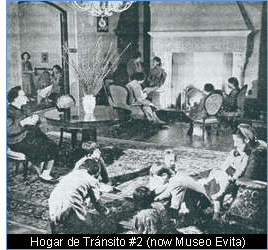 Laws
were passed which punished those who spoke the names Perón, Eva Perón,
Evita, or who kept their pictures at home with up to six years in prison.
Peronistas who resisted were imprisoned and tortured; some were shot. Laws
were passed which punished those who spoke the names Perón, Eva Perón,
Evita, or who kept their pictures at home with up to six years in prison.
Peronistas who resisted were imprisoned and tortured; some were shot.
Commissions and subcommissions were created
to dismantle the Fundación and dispose of its capital. Subcommission #39
complained that "an organization destined to help the humble had offered
its services with a luxury all out of proportion to its goals and to the
culture and customs of those destined to use its services." (20)
Translated out of bureaucratese this meant that a picture by Caravaggio
did not belong in a Temporay Home for women and children whose culture
was not sufficient to allow them to appreciate fine art. Therefore, the
objects d'art would be auctioned off or given to those who could appreciate
them (the oligarchy and the military, who behaved like vandals even though
Lonardi, one of the coup leaders had promised Argentines, "There will
be neither conquered nor conquerors").
The Comisión Nacional also had to admit
that: "In spite of the exhaustive investigation carried out, it has not
been possible to prove anything which would be penalized by law, because
all technical and legal proceedings have at all times fallen within routine
administrative norms, but neither can we doubt that some sections heads
were compromised as many details lead us to this conclusion although it
is impossible to prove it since we lack indispensable elements so we can
take no legal action against them." (20)
In 1990, Cereijo calculated that, taking
into account the dollar/peso exchange rate on September 24, 1955, the
Fundación's debt-free capital would be U$S 289,067,791.94. If you added
a four percent interest rate, you would get U$S 1,014,066,796.50. (22)
What happened to the patrimony of the Fundación?
"A very Catholic lady, Adela Caprile, a
member of the liquidating commission of the foundation that was established
after the fall of Peronism, [said], "It was... not a fraud. Evita cannot
be accused of having kept one peso in her pocket. .... I would like to
be able to say as much of all the ones who collaborated with me in the
dissolution of the organization." (23)
Adela Caprile's words turn on their head
the lyrics of Andrew Lloyd Weber's Opera Evita: "When the money
keeps rolling out, you don't keep books... Accountants only slow things
down, figures get in the way... ."
The Argentines who participated in the government
established by the military coup of 1955 were intent on the destruction
not the preservation of works and documents; however, they were not entirely
successful. The Fundación's accountants, beginning with Cereijo, DID keep
books and COULD account for every cent of the workers' money. Those who
have implied otherwise have done Evita a grave injustice. Fortunately,
for those interested in historical research, the truth can still be found.
Nestor Ferioli, La Fundación Eva Peron/ 1, Centro Editor
de America Latina, 1990, p. 37..
Marysa Navarro, Evita (Buenos Aires: Corregidor, 1981) 250.
Ferioli, p. 41.
Ferioli, p. 41.
La Nación, March 27, 1945.
Carmen LLorca, Llamadme Evita (Barcelona:Planeta, 1981) p. 206.
Ferioli, p. 43- 44.
Ibid, p. 42 9.
Rafael Urruela, Argentine Journey (Inter American News Association:
New Orleans, 1948) p. 77.
Ferioli, p. 44.
Ferioli, p. 45.
Ferioli, p. 44- 45.
Ferioli, p. 40.
Navarro, p. 253. Ferioli, vol. 2, pgs. 161-162.
Ferioli, p. 40- 41.
Ferioli, p. 41.
Navarro, p. 251.
Ibid, 313-314.
Urruela, p. 154.
Vicepresidente de la Nación. Comisión Nacional de Investigaciones:
Documentación, Autores y Cómplices de las Irregularidades Cometidas durante
la Segunda Tiranía (Tomo III, Buenos Aires, 1958).
Ibid, p. 269.
Ferioli, pgs. 165-166.
Alicia Dujovne Ortiz, Eva Perón (New York: St. Martin's Press,
1997) p. 236.
|
